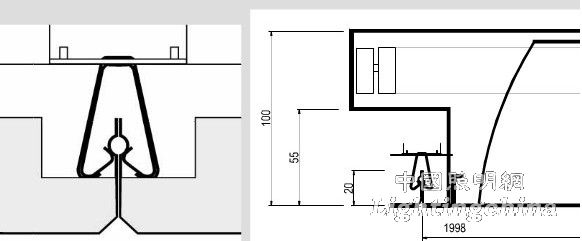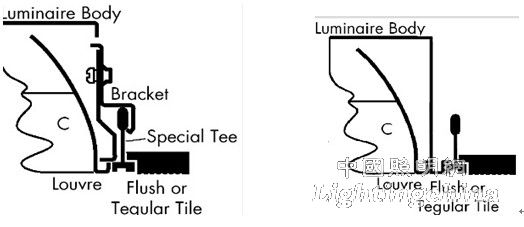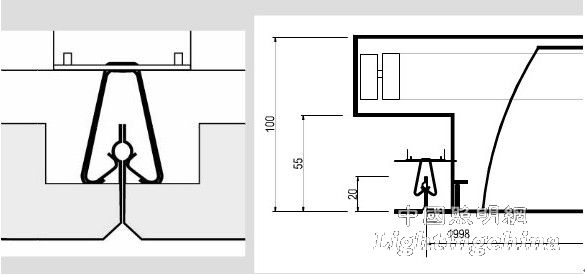1 Introduction
In this era of human pursuit of beauty, in this era of demanding simplicity and efficiency, in this era of energy shortage and technology leap, in this era of mentality, environment, and comfort. The pros and cons of the office environment will directly affect the mood and work efficiency of our work. A safe environment, bright light, spacious space, and comfortable temperature have always been our tireless pursuit.
2. The use of air conditioning lamps
For modern indoor lighting, especially for large-open office lighting, the ceilings that are open everywhere are increasingly criticized by designers and users. The messy air conditioning vents, smoke and fire sprinklers, lamps, etc., all seem essential. Admittedly, these devices are indispensable in modern offices for safety and functional needs. So, how can we make our space more beautiful? Can we make air-conditioning vents and lamps together? Through the cooperation of lighting manufacturers and air-conditioning manufacturers, air-conditioning lamps have emerged.
3. Difficulties in air conditioning lamps
3.1 Ambient temperature affects luminous flux
It is well known that the luminous flux of a light source is closely related to the ambient temperature. The maximum luminous flux of a fluorescent tube must be illuminated for half an hour before it can be achieved. The air outlet is the lowest indoor temperature. Does the long-running air conditioning vent affect the illuminance of the luminaire?
3.2 Condensate is the deadly killer of air-conditioning lamps
Water entering the appliance can cause damage. The temperature at the air vent is low, and it is easy to form condensate. Once the lamp panel enters the water, it will cause the lamp panel to rust, the ballast and the connecting member to be short-circuited, and the light source to be damaged. How to deal with the condensate of the tuyere of the lamp becomes a difficult point of the air-conditioning lamp.
4 characteristics of air conditioning lamps
4.1 Functionality of lighting
Air-conditioning lamps must first reflect the function of lighting. That is, proper power and space spacing to ensure correct illumination and uniformity. Reasonable light distribution and cloth lighting are important guarantees for indoor lighting. The light emitted by the lamps needs to be illuminated to an effective area. Avoid light leakage, spill light and glare. The width of the air outlet and the air inlet of the lamp will affect the light distribution of the original lamp. It is an ideal design method to increase the width of the air conditioner lamp, so that the lighting environment will not be changed.
4.2 Selection of air conditioning lamps
The selection of air-conditioning lamps is suitable for the entire environment and architectural style. Generally, in a large space office area, it is not necessary for all the lamps to be air-conditioning lamps. Therefore, the matching of ordinary lamps and air-conditioning lamps is very important, and it is essential to reflect the uniformity of lamps with different functions in space. For example, we have a set of mahogany furniture, but the seat is white cortex, which will affect the overall effect of the space is very uncoordinated. The same is true for the luminaires. It is best to add vents to the luminaires of the same type.
4.3 Combination of air conditioning lamps and static pressure boxes
The so-called static pressure box is a device for reducing the wind noise and increasing the air output rate of high-power air conditioners. Whether the combination of air-conditioning lamps and static pressure box air outlets directly affects the use of lamps and air conditioners. In order to prevent air leakage, the interface between the lamp and the static pressure box must be tight, and the fireproof bead should be added in the middle, and then the centrifugal glass wool or rubber insulation material should be wrapped. A sufficient ventilation space needs to flow out between the luminaire and the static pressure box to avoid radiation radiation and heat conduction of the lamp panel and to lose energy consumption of the air conditioner. Condensed water is generated in the inner tank wall of the static pressure tank, so the waterproof strip is required to be combined with the ventilator to prevent the condensed water from damaging the lamp body and electrical components.
4.4 Combination of air conditioning lamps and ceiling keels
Smallpox is an essential decorative material for large space office areas. The existing smallpox on the market is generally divided into metal ceiling, mineral wool ceiling and gypsum board ceiling. Gypsum board ceiling can be directly opened on the surface of the plaster, and the lamp can be installed by inserting and pressing. Then the combination of metal ceiling and mineral wool board ceilings and lamps will directly affect the aesthetics of the decoration, so the air-conditioning lamps should also consider the matching form with various ceiling keels. The following figure shows the matching form of air-conditioning lamps and various keels.

T-shaped keel and matching form of lamps

Concave keel outer arm type concave keel suspension type

Metal gusset ceiling combination
4.5 Material and design of air conditioning lamp panel
Compared with ordinary light panels, the air conditioner type lamp must have special requirements. Since the air conditioning tuyere is attached to the lamp body, the temperature difference of the lamp itself is quite large. Due to the influence of long-term thermal expansion and contraction, the selection of inferior materials may cause deformation of the lamp body. The influence of condensed water is also a hidden danger, so the anti-corrosion and anti-off paint of the lamps should also be cautious. The following are the key points of the material and design of the luminaire:
▲ The thickness of high-quality cold-rolled steel plate is ≥0.8mm, and it can be used without deformation.
â–² All metal parts must be treated with anti-corrosion treatment
â–² Electrostatic spray of lamp body, anti-corrosion and anti-aging
â–² The design of the luminaire is generally 65--80mm thick, and the depth of the light source is increased (not more than 90mm, affecting the luminous flux)
â–² The light source is as far as possible from the wind surface
â–² Grille type lamp panel should increase the number of grids as much as possible to reduce glare and protect the light source.
â–² The lighting design should be easy to replace the light source and ballast to avoid the secondary disassembly affecting the tuyere seal when replacing.
